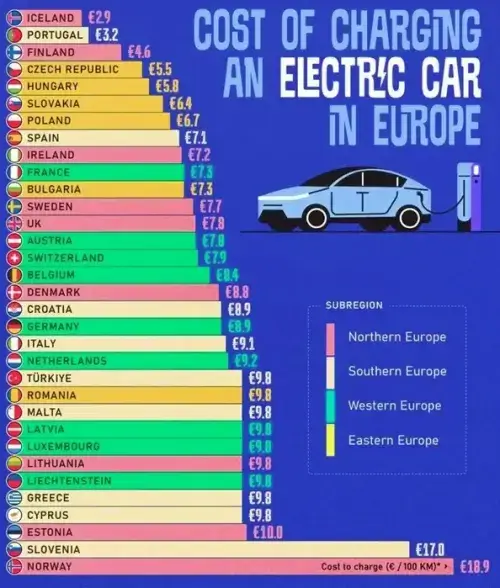Charging Costs Europe vs. the U.S. in 2024.
Electric vehicles (EVs) are transforming the global automotive industry, but how much does it cost to keep them charged?
According to the European Alternative Fuels Observatory (EAFO), charging an EV at public stations in Europe costs, on average, up to €5 per 100 kilometers.
However, these costs vary significantly between countries. Iceland boasts the cheapest EV charging rates, while Norway leads with the highest, reflecting the country’s higher overall cost of living.
Charging Costs, Norway: A Global EV Leader
Norway’s dominance in the EV market is unmatched. As of September 2024, electric vehicles outnumber traditional gasoline-powered cars on Norwegian roads.
In August alone, EVs accounted for 94.3% of new car sales—a world record. The Norwegian government aims to cease sales of new petrol cars entirely by 2025, underscoring its commitment to sustainability.
Despite high charging costs, Norwegians benefit from higher-than-average wages, making EV adoption more feasible.
This shift demonstrates how policy, infrastructure, and economic factors play a critical role in EV market growth.
Challenges in the U.S.: Copper Shortages Threaten EV Expansion
Across the Atlantic, the U.S. faces a different kind of hurdle: copper shortages. Transitioning to EVs demands a fivefold increase in copper consumption, according to researchers from the University of Michigan and Cornell University.
An electric car like the Honda Accord hybrid requires 18 kg of copper, compared to 90 kg for its fully electric counterpart.
The issue extends beyond cars. Expanding EV charging networks and renewable energy projects like wind farms require substantial copper supplies. An eight-megawatt offshore wind turbine alone uses 10 tons of copper.
Solutions and Innovations.
Innovations like Tesla’s Cybertruck offer hope. By utilizing a high-voltage, low-copper wiring system, the Cybertruck reduces copper usage by 50% compared to EVs from the 2010s.
Such advancements may ease the pressure on copper supplies while maintaining high-performance standards.
Renewable Energy and EVs: Myths and Realities
While EVs and renewable energy projects are pivotal for reducing carbon emissions, they come with their own challenges.
For instance, wind and solar farms face technical limitations that prevent them from fully replacing fossil fuels.
Similarly, the upfront costs of EVs, often exceeding $40,000, make them less accessible compared to traditional budget-friendly gasoline cars.
The Path Ahead.
The global transition to EVs is fraught with challenges, from resource constraints to infrastructure demands.
Yet, the opportunities for innovation and sustainability are immense. The key lies in balancing technological advancements with realistic policies to create a sustainable future for all.
Let’s stay informed and ready for a cleaner, greener tomorrow.




